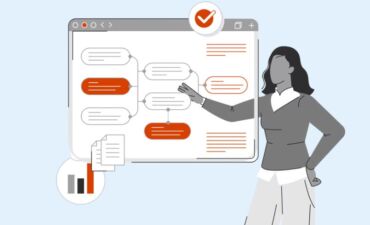Cloud-based audit technology is no longer an emerging trend. So, if you’re still asking yourself whether the cloud is the right move, the real question is whether your firm is keeping pace with the shift.
Today, successful audit firms are redefining their workflows by balancing cloud-based technology with traditional in-person practices. The result not only enhances efficiency but also improves the client experience by empowering teams to get more done.
While both remote and hybrid work models have gained traction in recent years, the true benefit lies in how the cloud empowers firms to operate with greater agility, ensuring consistency and quality across all engagements. By leveraging cloud-based audit technology, your staff can maintain the benefits of face-to-face client interactions while streamlining processes and boosting audit quality.
Still not convinced? Here are five reasons why it pays for audit teams to work in the cloud.
Jump to ↓
| 1. The ability to work smarter, not harder |
| 2. Automatic software updates |
| 3. Seamless integration of applications |
| 4. Improved client and staff collaboration |
| 5. A renewed focus on the human connection |
| Ready to audit in the cloud? |
1. The ability to work smarter, not harder
If your firm isn’t already in the cloud, there’s a strong chance your clients already are. Businesses of all sizes are increasingly becoming more comfortable with the cloud because they realize it makes it easier to get their work done, regardless of location.
With cloud-based audit technology, your staff can securely access workpapers, financial data, and collaboration tools from any device, ensuring continuity in engagements — even when team members are dispersed. This level of accessibility enhances responsiveness, allowing your firm to meet client needs in real time without compromising security or quality.
Whether working in the office, at a client site, or remotely, cloud-based tools provide the flexibility necessary to maintain productivity and consistency across engagements.
2. Automatic software updates
Have you ever had to update your own software? Even for IT professionals, this can take time and effort.
One of the primary advantages of cloud-based audit technology is the ease of software updates. Unlike traditional on-premise systems that require manual installations and downtime, cloud-based applications are updated automatically, ensuring that auditors always have access to the latest features and security enhancements. This eliminates delays and reduces the burden on IT departments, allowing firms to focus on delivering high-quality audits without the disruption of outdated or unsupported software. As regulations and industry standards evolve, cloud-based systems ensure compliance by keeping audit tools up to date with minimal effort.
Because cloud software is updated frequently, this is a task you will no longer have to worry about. Having the most current technology means you are getting the most out of your software — and maximizing the use of your staff’s valuable time.
3. Seamless integration of applications
Integration is another key benefit of cloud technology because it enables audit firms to connect various applications seamlessly. From engagement management to data analytics and workflow automation, cloud-based platforms eliminate redundancies and enhance productivity. By having all relevant data and tools within a unified ecosystem, teams can collaborate more effectively, reducing the need for manual data transfers and minimizing errors.
Without integration, employees must spend time shifting between separate information sources — a recipe for lower productivity and an ineffective use of a firm’s resources. Integration adds much-needed time back to your day.
With different points of work linked together, there is no need to re-enter data. This obviously saves time and reduces the opportunity for human error to take place. Cloud technology makes it possible to pull in information from paper documents, integrating them into your automated tax workflow using optical character recognition (OCR) technology. From there, all relevant information can be in one convenient location, allowing you to make optimal use of your time.
4. Improved client and staff collaboration
With secure portals and real-time document-sharing capabilities, cloud-based audit technology streamlines interactions between auditors and clients, reducing the delays associated with email-based communication. This not only speeds up the audit process but also fosters transparency and trust. Clients appreciate the ability to access reports, provide information, and track progress effortlessly, reinforcing a more collaborative and client-centric approach to audit engagements.
Cloud-based audit technology also enhances collaboration and communication among staff by providing a centralized platform where team members can securely access, share, and update audit files in real time. Say goodbye to email attachments or version tracking issues because everyone works from the same up-to-date documents, ensuring accuracy and consistency.
Built-in messaging, task assignments, and workflow automation features streamline internal communication, allowing teams to coordinate efficiently regardless of location. Whether working in the office, at a client site, or remotely, the cloud could help audit teams stay connected, track progress, and quickly address issues, resulting in a more seamless and productive work environment.
5. A renewed focus on the human connection
As accounting firms increasingly adopt cloud-based audit software, maintaining the human touch is essential for building strong client relationships and delivering high-quality service. While technology streamlines workflows and enhances efficiency, clients still value personalized interactions, expert judgment, and tailored guidance.
Cloud-based tools should be seen as a way to enhance — not replace — the human connection. By leveraging these solutions to automate routine tasks, your audit team can free up time to focus on deeper client conversations by providing insights that go beyond numbers, thus building trust in the advisory process.
Audit teams also benefit from maintaining a human-centered approach. While digital tools facilitate seamless file sharing and real-time updates, they should be complemented by meaningful discussions, mentorship, and strategic decision-making. Face-to-face meetings — whether in person or via video conferencing — can help reinforce your firm’s culture, support professional development, and ensure that teams remain aligned on complex engagements.
By blending technology with traditional collaboration methods, your firm can create a balanced approach that supports the human connection while making workflows more efficient, flexible, and client-focused.
Ready to audit in the cloud?
For more information on best practices in remote and hybrid audit environments, download our white paper, Audit from anywhere.
Ready to work from anywhere with cloud-based technology? Learn more about how Cloud Audit Suite can excel as your firm’s end-to-end solution.









